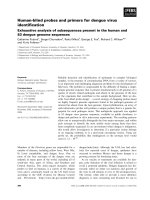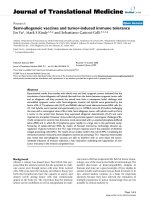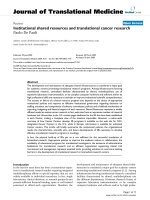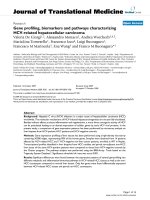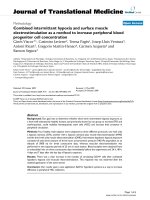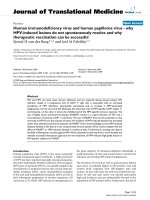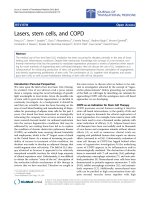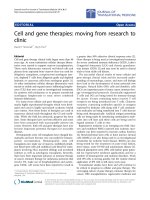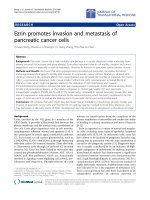Báo cáo hóa học: " Combined fluticasone propionate and salmeterol reduces RSV infection more effectively than either of them alone in allergen-sensitized mice" pptx
Bạn đang xem bản rút gọn của tài liệu. Xem và tải ngay bản đầy đủ của tài liệu tại đây (964.02 KB, 10 trang )
BioMed Central
Page 1 of 10
(page number not for citation purposes)
Virology Journal
Open Access
Research
Combined fluticasone propionate and salmeterol reduces RSV
infection more effectively than either of them alone in
allergen-sensitized mice
Rajeswari Singam, Prasanna K Jena, Sumita Behera, Gary R Hellermann,
Richard F Lockey, Dennis Ledford and Shyam S Mohapatra*
Address: Division of Allergy and Immunology, Joy McCann Culverhouse Airway Disease Research Center, University of South Florida College of
Medicine and James A. Haley VA Hospital, Tampa, FL, USA
Email: Rajeswari Singam - ; Prasanna K Jena - ; Sumita Behera - ;
Gary R Hellermann - ; Richard F Lockey - ; Dennis Ledford - ;
Shyam S Mohapatra* -
* Corresponding author
Abstract
Background: Respiratory syncytial virus (RSV) infection is the major cause of bronchiolitis in
infants and is a risk factor for the development of asthma. Allergic asthmatics are more susceptible
to RSV infection and viral exacerbation.
Methods: Since the effectiveness of corticosteroids in treating RSV infection has been
controversial, we tested fluticasone propionate (FP) and salmeterol (Sal) alone versus FP plus Sal
(FPS) on RSV-induced airway inflammation. Mice were sensitized and challenged with ovalbumin
(OVA) and infected with RSV. Following infection they were treated with FP, Sal, or FPS intranasally
and airway hyperreactivity (AHR), inflammation and RSV titers were examined.
Results: The group treated with FPS showed significantly lower AHR compared to the group
treated with FP or Sal alone. The group treated with FP alone showed slightly decreased (non-
significant) AHR compared to controls. Treatment with FPS resulted in significant decreases in the
percentage of eosinophils and neutrophils in bronchoalveolar lavage fluid and in lung pathology
compared to FP or Sal. FP alone decreased eosinophils but not neutrophils or lymphocytes, while
Sal alone decreased eosinophils and neutrophils but not lymphocytes. FPS treatment of mice
infected with RSV in the absence of allergen sensitization resulted in a 50% decrease of RSV titer
in the lung and a reduction in neutrophils compared to FP or Sal.
Conclusion: Together, these results indicate that fluticasone in combination with salmeterol is a
more effective treatment for decreasing airway hyperreactivity and inflammation than either of
them alone in allergen-sensitized, RSV-infected mice.
Introduction
Asthma is a chronic lung disease with two distinct features
– airway inflammation and airway hyperresponsiveness
[1,2]. An association between viral upper-respiratory
infections (URIs) and exacerbations of asthma has been
reported [3,4]. The most commonly identified viruses in
Published: 23 May 2006
Virology Journal 2006, 3:32 doi:10.1186/1743-422X-3-32
Received: 15 February 2006
Accepted: 23 May 2006
This article is available from: />© 2006 Singam et al; licensee BioMed Central Ltd.
This is an Open Access article distributed under the terms of the Creative Commons Attribution License ( />),
which permits unrestricted use, distribution, and reproduction in any medium, provided the original work is properly cited.
Virology Journal 2006, 3:32 />Page 2 of 10
(page number not for citation purposes)
these studies include rhinovirus, coronavirus, influenza
virus and respiratory syncytial virus (RSV) [5]. RSV is the
predominant cause of URIs in infants below 2 years of age
and infection may result in bronchiolitis, which is a risk
factor for asthma [6-12]. RSV may constitute the earliest
trigger for the development of a T-helper type 2 (Th2)-
dominant immune response, which is the hallmark of
immunopathology in allergic subjects including asthmat-
ics, and also in rodent models [13]. URIs cause a decrease
in peak flow that lags behind upper airway symptoms by
1–2 days, with 46% of subjects in one study reporting a
two day lag in peak flow reduction [14].
A combination therapy involving a long-acting β2 agonist
and an inhaled corticosteroid (ICS) has emerged as an
effective asthma management strategy to control persist-
ent asthma [15]. A combination of salmeterol (Sal) and
fluticasone propionate (FP) was found to be superior to
either of them alone [16,17]. The combination is also sig-
nificantly more effective than montelukast plus FP or
monotherapy with inhaled budesonide [18]. The
increased effectiveness of FPS has been attributed to
increased activation and translocation to the nucleus of
glucocorticoid receptors [19,20]. However, the effect of
these drugs on viral exacerbation in allergic asthmatics has
not been studied.
The conclusion of the Cochrane Review of available con-
trolled trials of ICS in children with a history of mild epi-
sodic viral wheeze was that high dose ICS was partially
effective for the treatment of mild episodic viral wheeze of
childhood [21]. Since URIs induce exacerbations, β2-ago-
nists may be of specific value in reducing such exacerba-
tions. In an in vitro study of Pseudomonas aeruginosa
infection, a combination of FP and Sal reduced infection
and preserved ciliated cells to a greater degree than either
alone suggesting synergy between the two agents [22].
Because 80–85% of asthma exacerbations in children are
associated with viral infections, early intervention with a
combination therapy should have beneficial effects on
viral asthma exacerbations.
Since virus-induced exacerbation is accompanied by air-
way inflammation, we reasoned that the combination of
a steroid and a β-2 agonist might provide protection from
severe RSV infection and the ensuing asthma exacerba-
tion. This hypothesis was tested in a mouse model of aller-
gen sensitization and RSV infection using OVA as the
allergen [1]. Mice with chronic or acute sensitization to
OVA were RSV infected and then treated with FP or Sal or
the two together (FPS). Airway hyperreactivity (AHR) and
pulmonary inflammation were measured five days after
infection. The results show that the combination of FP
and Sal provides significant protection in terms of both
airway hyperreactivity and pulmonary inflammation
compared to either of them alone.
Methods
Animals
Female BALB/c mice, 4–6 weeks of age were obtained
from Charles River and housed under pathogen-free con-
ditions at the University of South Florida Vivarium. All
treatment protocols were approved by the USF Institu-
tional Animal Care and Use Committee (IACUC).
RSV preparation and infection of mice
The A2 strain of human RSV (American Type Culture Col-
lection, Manassas, VA) was propagated in HEp-2 cells
(American Type Culture Collection) grown in Eagle's min-
imal essential medium (Gibco) with 2% FBS. At maxi-
mum cytopathic effect, the cells were harvested in the
same medium. The suspension was clarified by centrifuga-
tion at 700 × g for 10 min at 4°C and the resulting super-
natant was layered onto a glycerol gradient and
centrifuged at 14,000 × g for 3 hrs at 4°C. The pellet con-
taining virus was resuspended in pre-cooled (4°C) buffer
(0.22 µ-filtered 50 mM HEPES (pH 7.5), 100 mM MgSO
4
,
and 150 mM NaCl) and stored in aliquots in liquid nitro-
gen. Viral titers were determined by standard plaque assay
combined with immunostaining for RSV. Mice were
infected under light anesthesia by intranasal inoculation
of RSV (5 × 10
6
PFU).
OVA sensitization, RSV infection and drug treatment
For experiments in which only a single RSV infection was
used (therapeutic regimen), mice were sensitized by intra-
peritoneal injection (i.p.) of OVA on day 1 and by intra-
nasal (i.n.) administration of OVA on days 7 and 9. On
day 9 the mice were infected i.n. with of RSV. From day 10
to day 13 they were treated daily i.n. with fluticasone (FP)
propionate, salmeterol (Sal), or the two in combination
(FPS) at 10 µg per mouse (FP and Sal were obtained from
GlaxoSmithKline). Airway hyperreactivity (AHR) was
measured on day 14 and on day 15 the animals were sac-
rificed. For the prophylactic experiments, mice were sensi-
tized by intraperitoneal injection (i.p.) of OVA on day 1
and by intranasal (i.n.) administration of OVA on days 9,
12 and 14. On day 19 the mice were infected i.n. with of
RSV. From day 21 to day 27 mice were treated daily i.n.
with FP, Sal, or the two in combination (FPS) at 10 µg per
mouse. On day 28, mice were reinfected with RSV and
then challenged i.n. with OVA. AHR was measured on day
29. On day 30 the mice were sacrificed and BAL fluid,
lungs and spleens were taken. All experiments were
repeated at least twice.
Determination of airway hyperreactivity (AHR)
AHR, expressed as enhanced pause (Penh), was measured
in unrestrained mice by whole body plethysmography
Virology Journal 2006, 3:32 />Page 3 of 10
(page number not for citation purposes)
(Buxco, Troy, NY). Groups of mice (n = 4) were exposed
for 5 min to nebulized PBS to establish a baseline then to
increasing concentrations (6–50 mg/ml) of nebulized
methacholine (MCh; Sigma, St. Louis, MO) in PBS. Chal-
lenges were done for 5 min followed by recordings of
Penh for 5 min. The Penh values were averaged and
expressed for each MCh concentration as a percentage of
the PBS baseline reading.
Bronchoalveolar lavage (BAL)
Lungs were lavaged using 500 µl of PBS and the BAL fluid
was kept at 4°C until processed. BAL cells were centri-
fuged onto microscope slides by Cytospin (Shandon) and
stained using the Hema3 kit (Fisher). Eosinophils, neu-
trophils and lymphocytes were counted from 5 different
fields on 4 different slides from each group in a blinded
fashion.
Immunohistochemical analysis
Lung sections were stained with hematoxylin and eosin
(H&E) and inflammation was assessed as disruption or
denudation of the epithelial layer and infiltration of
monocytes and lymphocytes into the perialveolar region.
Lung sections were also stained with antibodies to the
cell-adhesion molecule ICAM-1, the goblet cell marker
Muc-5A, and the Th2 marker T1/ST2 (Santa Cruz BioTech,
Santa Cruz, CA).
Isolation of spleen cells and intracellular cytokine staining
Mice were sacrificed and single-cell suspensions were pre-
pared from the spleens and cultured for 24 to 48 hrs in
DMEM with 10% FBS. Splenocytes were incubated on
anti-CD3-coated or OVA-coated plates for 24 h and then
treated with Golgi-Stop for 4 hr to block the secretion of
cytokines. Cells were surface-stained with FITC-anti-CD4
(Research Diagnostics, Flanders, NJ) and then subjected
to intracellular staining with PE-anti-IFN-γ, -IL10 or -IL-4
antibodies (R&D Systems, Minneapolis, MN). Cells were
analyzed by flow cytometry gated on CD4
+
cells. The per-
centages of CD4
+
cells secreting the respective cytokines
are shown.
Measurement of cytokine levels in BAL cells
Mice were sacrificed and lungs were lavaged with PBS.
Aliquots of the BAL fluid were stored at -80°C until
assayed. The concentration of IFN-γ in the BAL was meas-
ured by ELISA using a kit (R&D Systems, Minneapolis,
MN), and the results were expressed as pg of IFN-γ per ml
of BAL fluid.
Apoptosis detection
Lung sections were processed for detection of apoptosis
using the DeadEnd™ Fluorometric TUNEL System assay
kit (Promega). Dewaxed sections were fixed and perme-
ablized, then incubated with terminal deoxynucleotidyl
transferase to label DNA ends with FITC-dUTP. Stained
sections were photographed under a fluorescent micro-
scope.
Statistical analysis
All data were expressed as mean ± SEM. For comparison
of two different groups, Student's t test was used. Differ-
ences between groups were considered significant at P <
0.05.
Results
FPS is more effective than FP or Sal alone in preventing
AHR and lung inflammation
Mice were sensitized with OVA on day 1 i.p. and on day 7
and 9 i.n. On day 9 they were infected with 5 × 10
6
PFU
RSV. From day 10 to 13 they were treated with 10 µg of FP,
Sal or FP/Sal combination (FPS). AHR was measured as
Penh on day 14 (Fig. 1A). On day 15 the mice were sacri-
ficed, BAL was done and a differential cell count was per-
formed on the BAL fluid (Fig. 1B). Lung sections were
stained with H &E and examined for histopathology (Fig.
1C). Mice treated with FPS, FP and Sal all showed reduced
eosinophil numbers but no change in neutrophils. Sal-
treated mice showed an increase in the number of lym-
phocytes. Combination therapy resulted in a significant
reduction in eosinophil number as well as lung inflamma-
tion compared to the other treatments. Lungs of allergen-
sensitized and RSV-infected mice exhibited cellular infil-
tration with MNC and eosinophils (Fig. 1C).
FPS is more effective than FP alone in reducing viral
exacerbation of asthma
Mice were sensitized with OVA i.p. on day 1 and on day 9,
12 and 14 i.n. On day 19 the mice were infected i.n with
RSV (5 × 10
6
PFU). From day 21 to day 27, mice were
treated i.n. with 10 µg of FP or FPS. On day 28 mice were
reinfected with RSV and challenged with OVA. AHR was
measured on day 29 and was lower in FPS-treated mice
than those treated with FP or Sal alone (Fig. 2A). On day
30 the mice were sacrificed and BAL fluid was taken and
analyzed for lymphocytes, eosinophils and neutrophils by
differential staining. Treatment with FPS reduced the
number of eosinophils and neutrophils compared to
either drug alone (Fig. 2B). Lung sections showed exten-
sive epithelial disruption and cellular infiltration in the
case of RSV exposure without drug treatment. FP or S
alone reduced the pathology somewhat but the combina-
tion FPS was significantly more effective (Fig. 2C). The
results showed that FPS significantly attenuated AHR and
inflammation, as seen by the decrease in eosinophils and
lymphocytes and the reduced perialveolar damage com-
pared to control group and mice treated with FP alone.
Virology Journal 2006, 3:32 />Page 4 of 10
(page number not for citation purposes)
FPS is more effective than FP or Sal alone in preventing AHR and lung inflammationFigure 1
FPS is more effective than FP or Sal alone in preventing AHR and lung inflammation. Mice were sensitized with
OVA and infected with RSV as described in Methods. From days 10 to 13 mice were treated daily with FP, Sal or FPS. AHR was
measured on day 14 (A). On day 15 the mice were sacrificed and a BAL cell differential was performed for macrophages (mac),
eosinophils (eos), neutrophils (neut) and lymphocytes (lym) (B) and H & E stained lung sections were examined for histopa-
thology (C). Results shown are one representative experiment of two.
Methacholine, mg/ml
Control
Sal
RSV
FP
FPS
*
1000
500
-500
0
012.525
%PENH
RSV
Sal
FP FPS
A
0
40
80
120
mac eos neut lym
% BAL Cells
FPS
FP
Sal
Control
RSV
B
C
Virology Journal 2006, 3:32 />Page 5 of 10
(page number not for citation purposes)
FPS is more effective than FP or Sal alone in reducing viral exacerbation of asthmaFigure 2
FPS is more effective than FP or Sal alone in reducing viral exacerbation of asthma. Mice were sensitized with
OVA and infected with RSV as described in Methods. From days 21 to 27 mice were treated daily with FP, Sal or FPS. On day
28, they were reinfected with RSV and then challenged with OVA. AHR was measured on day 29 (A). On day 30 the mice
were sacrificed and a BAL cell differential was performed for macrophages (mac), eosinophils (eos), neutrophils (neut) and lym-
phocytes (lym) (B). H & E stained lung sections were examined for histopathology (C). Results are from one representative
experiment of two performed.
RSV FP FPS
C
0
40
80
% BAL Cells
FP
FPS
Control
mac eos neut lym
B
0
100
200
300
400
06.2512.52550
Methacholine, mg/ml
Control
FP
FPS
%PENH
A
Virology Journal 2006, 3:32 />Page 6 of 10
(page number not for citation purposes)
Effect of FPS combination on cytokine and inflammatory
marker expression
To determine the effects of FPS therapy on T-cell cytokine
secretion, mice were OVA-sensitized, infected with RSV
and treated with FP, Sal or FPS. Mice were sacrificed after
drug treatment and their splenocytes were examined for
cytokine production by intracellular cytokine staining
(Fig. 3A & B). Cells were stimulated with anti-CD3 in
panel A and with OVA in panel B. FP increased the
number of cells producing IL-10 and Sal increased cells
producing IL-4, whereas FPS decreased the number of
cells producing IL-10, IL-4 and IFN-γ. Lung epithelial cells
respond to inflammatory cytokines by expressing specific
cell markers such as the intracellular adhesion molecule,
ICAM-1, and the mucin gene, MUC-5A. Fig. 4 shows the
results of an immunohistochemical analysis for ICAM-1
and Muc-5A in mouse lung sections. RSV infection
increased the expression of ICAM-1 and mucin, whereas
treatment with FPS decreased their expression compared
to control mice. Another correlate of lung inflammation is
the infiltration of T lymphocytes into the perialveolar tis-
sue. A Th2-specific marker, T1/ST2, was used to stain lung
sections, and both Sal and FPS appear to stimulate infil-
tration of T cells of the Th2 type into the lung (lower
panel, Fig. 4).
FPS inhibits apoptosis of lung cells
Previous work from our lab documented the apoptosis of
lung cells as a consequence of OVA-induced inflamma-
tion in OVA-sensitized mice. Here we sought to determine
the effect of FP and Sal or the combination on this apop-
tosis. Mice were OVA-sensitized, RSV-infected and treated
with the various drug combinations. At the end of treat-
ment they were sacrificed, lungs were removed and sec-
tions were examined for apoptosis using the TUNEL
(terminal deoxynucleotidyl transferase nick end-labeling)
assay. Fig. 5 shows a representative experiment in which
apoptosis was induced in a population of cells in the
lungs of OVA-sensitized, RSV-infected mice. The extent of
apoptosis was reduced by treatment with FP and Sal, and
especially by FPS.
FPS decreases RSV titer and increases IFN-
γ
production
Two groups of mice were sensitized with OVA i.p. and
then prophylactically treated with FP, Sal or FPS prior to
infection with RSV. Three days after infection, they were
sacrificed. Lungs were removed from one group of mice,
homogenized and the titer of RSV determined by plaque
assay. BAL fluid was taken from the second group and
analyzed by ELISA for IFN-γ. The decreased burden of
virus in the lung tissue of FPS-treated mice was matched
by an increase in secreted IFN-γ in BAL fluid (Fig. 6).
FPS reduces production of cytokines by CD4
+
cellsFigure 3
FPS reduces production of cytokines by CD4
+
cells. Mice were sensitized with OVA, infected with RSV then treated
with FP, Sal or FPS as in Fig. 1A. They were sacrificed on day 15 and their splenocytes were examined for cytokine production
by intracellular cytokine staining. Splenocytes were incubated on anti-CD3-coated plates (A) or with medium containing OVA
(B) for 24 h and then treated with Golgi-Stop for 4 h to block cytokine secretion. Cells were surface-stained for CD4 and
intracellularly for IFN-γ, IL10 or IL-4. The percent of CD4-gated cells producing the respective cytokine is shown. Results are
from one representative experiment of two.
0
2
4
6
FP
Sal
FPS
RSV
Naive
% Gated CD4+ Cells
IFN-J IL-10 IL-4
0
0.2
0.4
0.6
0.8
IFN-J IL-10 IL-4
A
B
Virology Journal 2006, 3:32 />Page 7 of 10
(page number not for citation purposes)
Increased IFN-γ production could, at least in part, account
for the reduction in RSV titer.
Discussion
Our goal in this study was to determine if the combina-
tion of a corticosteroid and a long-acting β2-agonist was
more effective in reducing RSV-induced asthma exacerba-
tion than either drug alone. Here we demonstrate a reduc-
tion in lung inflammation in OVA-allergic mice infected
with RSV after treatment with combined fluticasone and
salmeterol. Eosinophil migration to the lung is character-
istically seen during RSV-induced exacerbation of asthma
[23], and both fluticasone and salmeterol reduced the
eosinophil numbers in BAL fluid; but the combination of
the two drugs was most effective. The basis of this synergy
and whether the combination will be effective in infants
and children affected by exposure to both viruses and
allergens is unclear.
One important finding of this study is that irrespective of
the frequency of RSV infection, the FPS combination ther-
apy was effective and significantly decreased AHR as
measured by % Penh. Also, in studies in which mice were
infected twice with RSV, FPS decreased AHR more than FP
alone. These results are in agreement with previous
reports, where steroid or β2-agonists alone was found to
be partially effective in RSV infection and viral induced
asthma [24-26]. Consistent with the AHR data, there was
a substantial reduction in pulmonary inflammation irre-
spective of the frequency of RSV infection. Of note is that
in experiments where mice sensitized with OVA received
one RSV infection, there was a decrease in eosinophils but
an increase in lymphocytes. In contrast, OVA-sensitized
mice that had two RSV infections before FP showed an
increase in neutrophils. This is probably due to the resist-
ance of neutrophils to corticosteroids and to the genera-
tion of a greater number of infiltrating neutrophils by the
repeated RSV infection. The former possibility is consist-
ent with the findings that neutrophilic asthma is resistant
to treatment by FP [27]. This suggests that addition of the
long-acting beta agonist is the agent primarily affecting
recruitment of neutrophils in the combination.
Furthermore, single versus double RSV infection induced
significant differences in the expression of specific
cytokines such as IL-10 and IL-4. RSV infection in BALB/c
FPS decreases expression of inflammatory markers in the lungFigure 4
FPS decreases expression of inflammatory markers in the lung. Mice were sensitized with OVA, infected with RSV
then treated with FP, Sal or FPS. They were sacrificed on day 15 and lung sections were stained for ICAM-1, Muc-5A or T1/
ST2. Arrows indicate areas of staining by specific antibodies. Results are from one representative experiment of two.
RSV FP SAL FPS OVA
ICAM-1
MUC-5A
T1/ST-2
Virology Journal 2006, 3:32 />Page 8 of 10
(page number not for citation purposes)
mice has been shown to increase a variety of cytokines
and chemokines including TNF-α, IFN-γ, IL-6, IL-4, IL-10,
RANTES, macrophage inflammatory protein-1 alpha, and
eotaxin [28]. Mice with a single infection showed an
increased percentage of IL-10-producing cells perhaps
indicative of greater stimulation of the innate immune
system [29]. Treatment with salmeterol alone resulted in
a significantly higher percentage of IL-4-producing cells
characteristic of the Th2-type response observed in
human infants suffering from acute RSV bronchiolitis
[30] while FPS decreased both IL-10 and IL-4. The num-
bers of cytokine-producing cells in splenocyte cultures are
in agreement with the increased number of Th2-like cells
seen in lung sections from salmeterol-treated mice. In
mice infected twice with RSV, FPS reduced IL-10 but not
IL-4 compared to FP or salmeterol alone This is consist-
ent with our previous finding that allergic mice with two
RSV infections had an increase in the number of cells pro-
ducing IL-4 and IL-13 [1]. Increased IL-10 production has
been associated with recurrent wheezing in children hos-
pitalized for RSV bronchiolitis [31,32].
Another significant observation is the differential effect of
FP and Sal on inflammatory markers. FP treatment caused
an increase in ICAM-1 expression whereas Sal showed a
small decrease. Treatment with the combination resulted
in a decrease of ICAM-1 expression. This observation is
consistent with previous reports which showed that FPS
combination decreased ICAM-1 expression in human
lung fibroblast cells [33,34]. The expression of MUC-5A,
which is a marker for mucus production, was also
decreased by combined FPS treatment, but not signifi-
cantly by either FP or Sal alone. Staining for the Th2-spe-
cific marker, T1/ST2 demonstrated the RSV-induced
infiltration of Th2 cells. While treatment with FP
increased ICAM-1 and MUC-5 expression, Th2 infiltration
in lungs of FP-treated mice was decreased. In contrast,
treatment with Sal did not inhibit Th2 infiltration. The
combination FPS treatment decreased Th2 infiltration
compared with Sal indicating that steroids and β
2
-agonists
differentially affect inflammatory parameters, but that the
two in combination can effectively reduce RSV-induced
lung inflammation.
Apoptosis of lymphocytes in the lung is a characteristic
feature of RSV bronchiolitis and may increase the severity
of the disease [35]. Our results indicated that compared to
lungs of mice sensitized with OVA in the presence or
absence of RSV infection, lungs of mice treated with either
FP or Sal and the combination FPS showed a decreased
number of apoptotic cells. The FPS combination shows
even fewer apoptotic cells compared to FP or Sal alone
suggesting the greater effectiveness of the combination
treatment. The reason for this is unclear, but it may be due
to the fact that treatment with FP or Sal decreases infiltra-
tion of inflammatory cells to the lungs. This idea is con-
sistent with the report that FPS increases apoptosis of
peripheral blood T cells [36].
FPS decreases apoptosis in the lungFigure 5
FPS decreases apoptosis in the lung. Mice were sensitized with OVA, infected with RSV then treated with FP, Sal or FPS.
They were sacrificed on day 15 and lung sections were analyzed for apoptotic cells by TUNEL assay. DAPI stains nuclear DNA.
Results are from one representative experiment of two.
RSV FPSFP SAL OVA
DAPI
TUNEL
Virology Journal 2006, 3:32 />Page 9 of 10
(page number not for citation purposes)
Treatment with FP plus Sal decreases lung inflammation
and examination of lung homogenates for RSV revealed a
reduction in virus titer in the mice treated with FPS, sug-
gesting that the combination treatment exerts additional
antiviral effects. The measurement of IFN-γ in BAL fluid
showed an increased production of IFN-γ in the lungs of
mice treated with FPS therapy. Thus, the observed reduc-
tion in RSV titer may be due to increased IFN-γ levels in
the lungs induced by the FPS combination therapy.
Although a number of experimental approaches are under
investigation for the treatment of RSV infection [37-40],
the possibility that such infection can be managed using
already available therapies is an important finding. The
results of this -study show that OVA-sensitized mice
receiving fluticasone plus salmeterol had a significant
reduction in RSV-induced inflammation and RSV titers
compared to those receiving the drugs individually. Our
results suggest that the use of a combination therapy can
be very effective in reducing virally-induced asthma exac-
erbations.
Abbreviations
FP, fluticasone propionate; Sal, salmeterol; FPS, flutica-
sone plus salmeterol; RSV, respiratory syncytial virus;
AHR, airway hyperreactivity; ICS, inhaled corticosteroids;
OVA, ovalbumin; BAL, bronchoalveolar lavage; Th2, T
helper cell type 2; URI, upper respiratory infection; PFU,
plaque-forming units; i.p., intraperitoneal; i.n., intranasal;
Penh, enhanced pause; MCh, methacholine.
Competing interests
The author(s) declare that they have no competing inter-
ests.
Acknowledgements
SSM, RFL and DL designed the study and assisted in data evaluation and
presentation. RS prepared RSV, performed infections, drug treatments,
AHR measurements, and immunohistochemical analysis. PKJ performed
OVA sensitization and RSV infection. SB obtained BAL fluid, isolated splen-
ocytes and did cytokine assays. GRH performed apoptosis assays.
References
1. Matsuse H, Behera AK, Kumar M, Lockey RF, Mohapatra SS: Differ-
ential cytokine mRNA expression in Dermatophagoides fari-
nae allergen-sensitized and respiratory syncytial virus-
infected mice. Microbes Infect 2000, 2:753-759.
2. Kay AB: Asthma and inflammation. J Allergy Clin Immunol 1991,
87:893-910.
3. Gern JE, Busse WW: The role of viral infections in the natural
history of asthma. J Allergy Clin Immunol 2000, 106:201-212.
4. Minor TE, Dick EC, DeMeo AN, Ouellette JJ, Cohen M, Reed CE:
Viruses as precipitants of asthmatic attacks in children. JAMA
1974, 227:292-298.
5. Johnston SL, Pattemore PK, Sanderson G, Smith S, Campbell MJ,
Josephs LK, Cunningham A, Robinson BS, Myint SH, Ward ME, Tyrrell
DA, Holgate ST: The relationship between upper respiratory
infections and hospital admissions for asthma: a time-trend
analysis. Am J Respir Crit Care Med 1996, 154:654-660.
6. Rooney JC, Williams HE: The relationship between proved viral
bronchiolitis and subsequent wheezing. J Pediatr 1971,
79:744-747.
FPS reduction in RSV titer correlates with increased IFN-γ productionFigure 6
FPS reduction in RSV titer correlates with increased IFN-γ production. Two groups of mice were sensitized with
OVA, and then prophylactically treated with FP, Sal or FPS prior to infection with RSV. Three days after infection, they were
sacrificed. Homogenates of lungs from one group of mice were assayed for RSV titer, and BAL fluid from the second group was
assayed for IFN-γ. Results are from one representative experiment of two.
3.6
4.0
4.4
4.8
RSV Sal FP FPS
log
10
values
A
B
Publish with BioMed Central and every
scientist can read your work free of charge
"BioMed Central will be the most significant development for
disseminating the results of biomedical research in our lifetime."
Sir Paul Nurse, Cancer Research UK
Your research papers will be:
available free of charge to the entire biomedical community
peer reviewed and published immediately upon acceptance
cited in PubMed and archived on PubMed Central
yours — you keep the copyright
Submit your manuscript here:
/>BioMedcentral
Virology Journal 2006, 3:32 />Page 10 of 10
(page number not for citation purposes)
7. Gurwitz D, Mindorff C, Levison H: Increased incidence of bron-
chial reactivity in children with a history of bronchiolitis. J
Pediatr 1981, 98:551-555.
8. Hall CB, Hall WJ, Gala CL, MaGill FB, Leddy JP: Long-term pro-
spective study in children after respiratory syncytial virus
infection. J Pediatr 1984, 105:358-364.
9. Mok JY, Simpson H: Symptoms, atopy, and bronchial reactivity
after lower respiratory infection in infancy. Arch Dis Child 1984,
59:299-305.
10. Webb MS, Henry RL, Milner AD, Stokes GM, Swarbrick AS: Contin-
uing respiratory problems three and a half years after acute
viral bronchiolitis. Arch Dis Child 1985, 60:1064-1067.
11. Welliver RC, Duffy L: The relationship of RSV-specific immu-
noglobulin E antibody responses in infancy, recurrent wheez-
ing, and pulmonary function at age 7–8 years. Pediatr Pulmonol
1993, 15:19-27.
12. Sigurs N, Bjarnason R, Sigurbergsson F, Kjellman B, Bjorksten B:
Asthma and immunoglobulin E antibodies after respiratory
syncytial virus bronchiolitis: a prospective cohort study with
matched controls. Pediatrics 1995, 95:500-505.
13. Graham BS, Bunton LA, Wright PF, Karzon DT: Reinfection of
mice with respiratory syncytial virus. J Med Virol 1991, 34:7-13.
14. Johnston SL, Pattemore PK, Sanderson G, Smith S, Lampe F, Josephs
L, Symington P, O'Toole S, Myint SH, Tyrrell DA, Holgate ST: Com-
munity study of role of viral infections in exacerbations of
asthma in 9–11 year old children. BMJ 1995, 310:1225-1129.
15. Wray BB: Asthma: best treatment options. Ann Allergy Asthma
Immunol 2001, 87:9-12.
16. Nelson HS: Combination therapy of bronchial asthma. Allergy
Asthma Proc 2001, 22:217-220.
17. Barnes PJ: Scientific rationale for inhaled combination therapy
with long-acting beta2-agonists and corticosteroids. Eur
Respir J 2002, 19:182-191.
18. Lyseng-Williamson KA, Plosker GL: Inhaled salmeterol/flutica-
sone propionate combination: a pharmacoeconomic review
of its use in the management of asthma. Pharmacoeconomics
2003, 21:951-989.
19. Eickelberg O, Roth M, Lorx R, Bruce V, Rudiger J, Johnson M, Block
LH: Ligand-independent activation of the glucocorticoid
receptor by beta2-adrenergic receptor agonists in primary
human lung fibroblasts and vascular smooth muscle cells. J
Biol Chem 1999, 274:1005-1010.
20. Goleva E, Dunlap A, Leung DY: Differential control of TH1 ver-
sus TH2 cell responses by the combination of low-dose ster-
oids with beta2-adrenergic agonists. J Allergy Clin Immunol 2004,
114:183-191.
21. McKean M, Ducharme F: Inhaled steroids for episodic viral
wheeze of childhood. Cochrane Database Syst Rev 2000:CD001107.
22. Dowling RB, Johnson M, Cole PJ, Wilson R: Effect of fluticasone
propionate and salmeterol on Pseudomonas aeruginosa
infection of the respiratory mucosa in vitro. Eur Respir J 1999,
14:363-369.
23. Zhao J, Takamura M, Yamaoka A, Odajima Y, Iikura Y: Altered eosi-
nophil levels as a result of viral infection in asthma exacerba-
tion in childhood. Pediatr Allergy Immunol 2002, 13:47-50.
24. Noah TL, Wortman IA, Becker S: The effect of fluticasone propi-
onate on respiratory syncytial virus-induced chemokine
release by a human bronchial epithelial cell line. Immunophar-
macology 1998, 39:193-199.
25. Panitch HB: Respiratory syncytial virus bronchiolitis: support-
ive care and therapies designed to overcome airway obstruc-
tion. Pediatr Infect Dis J 2003, 22:S83-87.
26. Steiner RW: Treating acute bronchiolitis associated with RSV.
Am Fam Physician 2004, 69:325-330.
27. Kabra SK, Lodha R: Management of unresponsive asthma.
Indian J Pediatr 2004, 71:729-732.
28. Jafri HS, Chavez-Bueno S, Mejias A, Gomez AM, Rios AM, Nassi SS,
Yusuf M, Kapur P, Hardy RD, Hatfield J, Rogers BB, Krisher K, Ramilo
O: Respiratory syncytial virus induces pneumonia, cytokine
response, airway obstruction, and chronic inflammatory
infiltrates associated with long-term airway hyperrespon-
siveness in mice. J Infect Dis 2004, 189:1856-1865.
29. Krishnan S, Craven M, Welliver RC, Ahmad N, Halonen M: Differ-
ences in participation of innate and adaptive immunity to
respiratory syncytial virus in adults and neonates. J Infect Dis
2003, 188:433-439.
30. Legg JP, Hussain IR, Warner JA, Johnston SL, Warner JO: Type 1 and
type 2 cytokine imbalance in acute respiratory syncytial
virus bronchiolitis. Am J Respir Crit Care Med 2003, 168:633-639.
31. Bont L, Heijnen CJ, Kavelaars A, van Aalderen WM, Brus F, Draaisma
JT, Geelen SM, Kimpen JL: Monocyte IL-10 production during
respiratory syncytial virus bronchiolitis is associated with
recurrent wheezing in a one-year follow-up study. Am J Respir
Crit Care Med 2000, 161:1518-1523.
32. Bont L, Aalderen WM, Kimpen JL: Long-term consequences of
respiratory syncytial virus (RSV) bronchiolitis. Paediatr Respir
Rev 2000, 1:221-227.
33. Sabatini F, Silvestri M, Sale R, Serpero L, Giuliani M, Scarso L, Favini P,
Rossi GA: Concentration-dependent effects of mometasone
furoate and dexamethasone on foetal lung fibroblast func-
tions involved in airway inflammation and remodeling. Pulm
Pharmacol Ther 2003, 16:287-297.
34. Ek A, Larsson K, Siljerud S, Palmberg L: Fluticasone and budeso-
nide inhibit cytokine release in human lung epithelial cells
and alveolar macrophages. Allergy 1999, 54:691-699.
35. Roe MF, Bloxham DM, White DK, Ross-Russell RI, Tasker RT,
O'Donnell DR: Lymphocyte apoptosis in acute respiratory
syncytial virus bronchiolitis. Clin Exp Immunol 2004, 137:139-145.
36. Pace E, Gagliardo R, Melis M, La Grutta S, Ferraro M, Siena L, Bon-
signore G, Gjomarkaj M, Bousquet J, Vignola AM: Synergistic
effects of fluticasone propionate and salmeterol on in vitro
T-cell activation and apoptosis in asthma. J Allergy Clin Immunol
2004, 114:1216-1223.
37. Kumar M, Behera A, Matsuse H, Lockey R, Mohapatra SS: Intranasal
IFN-g transfer of prevents respiratory syncytial virus infec-
tion in BALB/c mice. Vaccine 1999, 18:558-567.
38. Kumar M, Behera AK, Lockey RF, Zhang J, Perez de la Cruz C, Chen
l, Leong KW, Huang S-K, Mohapatra SS: Intranasal gene transfer
by chitosan-DNA nanospheres protects BALB\C mice
against acute respiratory syncytial virus infection. Human
Gene Therapy 2002, 13:1415-1425.
39. Kumar M, Kong X, Behera A, Hellermann G, Lockey RF, Mohapatra
SS: Chitosan IFN-γ-pDNA Nanoparticle (CIN) Therapy for
Allergic Asthma. Genetic Vaccines and Therapy 2003, 1:3.
40. Zhang W, Yang H, Kong X, Mohapatra S, Juan-Vergara HS, Heller-
mann G, Behera S, Singam R, Lockey RF, Mohapatra SS: Inhibition of
respiratory syncytial virus infection with intranasal siRNA
nanoparticles targeting the viral NS1 gene. Nature Medicine
2005, 11:56-62.
